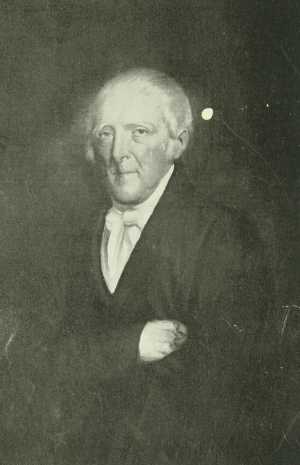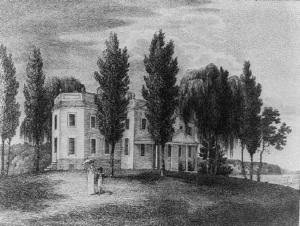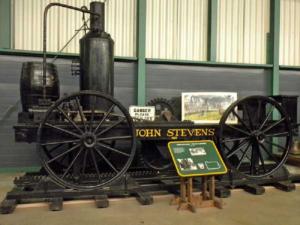 SKC Films Library SKC Films Library |
| |
| SKC Films Library >> Technology >> > Mechanical Engineering and Machinery > Steam Engineering |
 John Stevens John Stevens"father of the American steam engine" John Stevens was born in New York City
in 1749, the son of a very wealthy merchant and ship
owner. His father moved the family to Perth Amboy, New
Jersey, when John was still a boy. After graduating from
King's College in 1768, he studied law; although he was
admitted to the bar in 1771, he never practiced.
Appointed Captain in the Continental Army in 1776,
Stevens served as Treasurer of New Jersey (1776-1779) and
Surveyor of eastern New Jersey during the Revolutionary War
(1776-1779 and 1782-1783, respectively), achieving the
rank of Colonel for his services. On October 17,
1782, he married Rachel Cox, with whom he had eleven
children. left: Stevens' mansion, now home to the Stevens Institute of Technology Soon after purchasing his estate, Stevens bought the ferry service between Hoboken and New York City. After reading about steam engine designs developed by John Fitch and James Rumsey, he became convinced that steamships would allow him to greatly improve his ferry service. After enlisting assistance from Robert Livingston, a college friend now married to one of his sisters, and mechanic Nicholas Roosevelt, he began working on his own design for a steam engine. To protect his (and others') work, Stevens used his political connections to help the new U.S. Congress draft and pass the first U.S. Patent Act in 1790. He patented a steam engine with a vertical multitubular boiler the following year, a screw propellor in 1802, and his first steamboat (which incorporated both his multitubular boiler and his screw propellor) on April 11, 1803. The Little Juliana, named for his first daughter, made a successful crossing of the Hudson River in 1804, but by then Livingston had grown tired of waiting for Stevens to complete his work and had decided to invest his money in Robert Fulton's work on steamships. Although Stevens was deeply offended by Livingston's "defection," he carried on with his work. Improvements to Little Juliana eventually led to construction of the Phoenix, a larger steamship that could easily navigate smaller tributaries, in 1808. Since Livingston had also managed to get a monopoly on all commercial traffic on the Hudson River, Stevens decided to put the Phoenix into service on the Delaware River. In 1809, Stevens sailed the Phoenix to Philadelphia, making it the first steamship in the world to prove itself capable of ocean travel. After establishing a ferry service on the Delaware River, Stevens built the Juliana, a paddle-wheel steamship, which he put to work as a ferry on Long Island Sound in 1811. Although he was never able to break the Livingston-Fulton monopoly on the Hudson River and neither of his ferry services proved commercially successful in the long run, he did enjoy the satisfaction of knowing that his ferries used steam engines built in America, as opposed to those used by Fulton, which were built in England. Having proven the viability of using steam engines to power ships, Stevens next set his mind to developing them for railway use. In February of 1812, he addressed the commissioners appointed by the State of New York to explore a route for the Erie Canal, hoping to prove that railways would be much more in the public interest than the proposed canal. Many of the commissioners stood to profit personally from the canal and did not want competition from railways, however, and Stevens was unable to convince them to add a rail route to the canal route.
right: replica of a John Stevens locomotive Before his death on March 6, 1838, Stevens also designed a bridge and underwater tunnel from Hoboken to New York, as well as an elevated railroad system for New York City. SEE ALSO |
| SKC Films Library >> Technology >> > Mechanical Engineering and Machinery > Steam
Engineering This page was last updated on April 11, 2017. |

